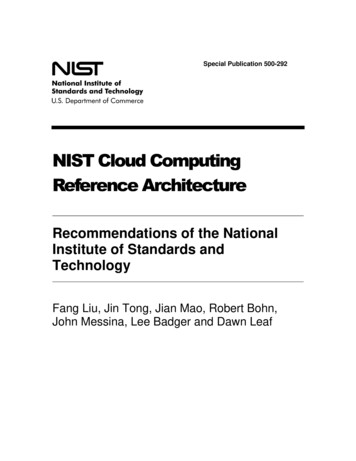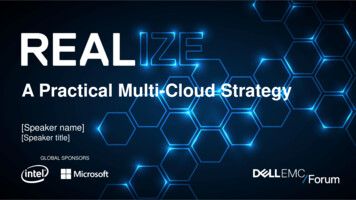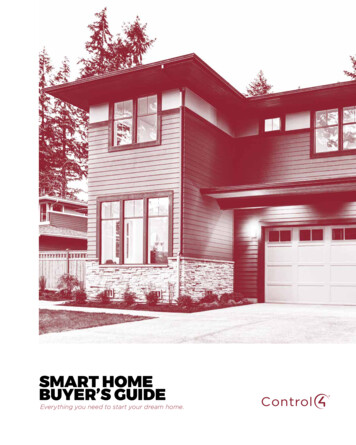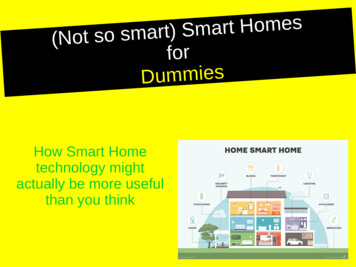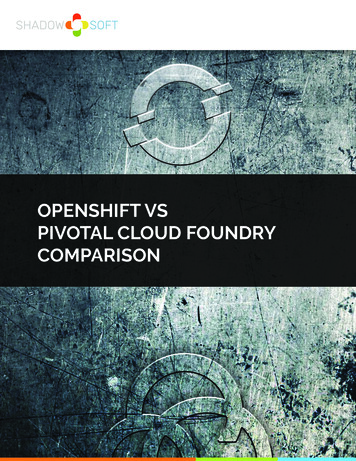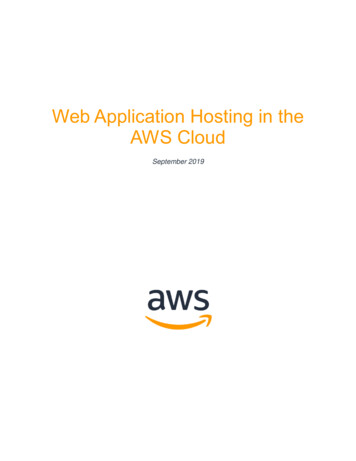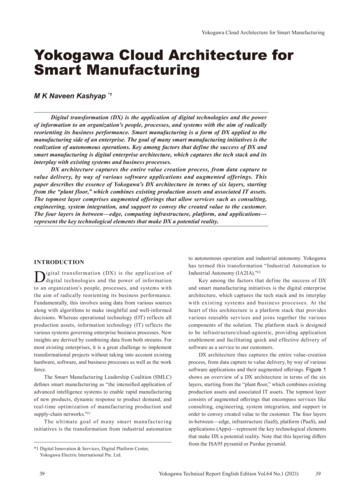
Transcription
Yokogawa Cloud Architecture for Smart ManufacturingYokogawa Cloud Architecture forSmart ManufacturingM K Naveen Kashyap *1Digital transformation (DX) is the application of digital technologies and the powerof information to an organization’s people, processes, and systems with the aim of radicallyreorienting its business performance. Smart manufacturing is a form of DX applied to themanufacturing side of an enterprise. The goal of many smart manufacturing initiatives is therealization of autonomous operations. Key among factors that define the success of DX andsmart manufacturing is digital enterprise architecture, which captures the tech stack and itsinterplay with existing systems and business processes.DX architecture captures the entire value creation process, from data capture tovalue delivery, by way of various software applications and augmented offerings. Thispaper describes the essence of Yokogawa’s DX architecture in terms of six layers, startingfrom the “plant floor,” which combines existing production assets and associated IT assets.The topmost layer comprises augmented offerings that allow services such as consulting,engineering, system integration, and support to convey the created value to the customer.The four layers in between—edge, computing infrastructure, platform, and applications—represent the key technological elements that make DX a potential reality.INTRODUCTIONDig it al t r a nsfor mat ion ( DX ) is t he applicat ion ofdigital technologies and the power of informationto an organization’s people, processes, and systems withthe aim of radically reorienting its business performance.Fundamentally, this involves using data from various sourcesalong with algorithms to make insightful and well-informeddecisions. Whereas operational technology (OT) reflects allproduction assets, information technology (IT) reflects thevarious systems governing enterprise business processes. Newinsights are derived by combining data from both streams. Formost existing enterprises, it is a great challenge to implementtransformational projects without taking into account existinghardware, software, and business processes as well as the workforce.The Smart Manufacturing Leadership Coalition (SMLC)defines smart manufacturing as “the intensified application ofadvanced intelligence systems to enable rapid manufacturingof new products, dynamic response to product demand, andreal-time optimization of manufacturing production andsupply-chain networks.”(1)T he ult i mate goal of ma ny sma r t ma nufact u r i nginitiatives is the transformation from industrial automation*1 Digital Innovation & Services, Digital Platform Center,Yokogawa Electric International Pte. Ltd.39to autonomous operation and industrial autonomy. Yokogawahas termed this transformation “Industrial Automation toIndustrial Autonomy (IA2IA).”(2)Key among the factors that define the success of DXand smart manufacturing initiatives is the digital enterprisearchitecture, which captures the tech stack and its interplaywith existing systems and business processes. At theheart of this architecture is a platform stack that providesvarious reusable services and joins together the variouscomponents of the solution. The platform stack is designedto be infrastructure/cloud-agnostic, providing applicationenablement and facilitating quick and effective delivery ofsoftware as a service to our customers.DX architecture thus captures the entire value-creationprocess, from data capture to value delivery, by way of varioussoftware applications and their augmented offerings. Figure 1shows an overview of a DX architecture in terms of the sixlayers, starting from the “plant floor,” which combines existingproduction assets and associated IT assets. The topmost layerconsists of augmented offerings that encompass services likeconsulting, engineering, system integration, and support inorder to convey created value to the customer. The four layersin-between—edge, infrastructure (IaaS), platform (PaaS), andapplications (Apps)—represent the key technological elementsthat make DX a potential reality. Note that this layering differsfrom the ISA95 pyramid or Purdue pyramid.Yokogawa Technical Report English Edition Vol.64 No.1 (2021)39
Yokogawa Cloud Architecture for Smart ese are solutions to customer problems(true source of customer value)ApplicationnServices and engineeringtoolsetsPlatform often called a “cloud OS”, something like the OSon which we build our applications.Infrastructure on which we run our software. The cloud isthe PC of the digital era, providing computing, storage, nted offerings convert our products and servicesinto solutions and solutions into business outcomes(consulting, system integration, etc.)Augmented offeringsPoint of convergence of IT and OT. This is the boundarybetween the “plant floor” and cloud. Comprises hardwareand software.HardwareSensors(IIoT)OT Systems(DCS, PLC, SCADA etc.)IT Systems(MES, ERP, PLM,CMMS etc.)Data sources: This is the plant floor, including sensors andsystems (hardware and software) and IT systems whichplay a role in process or production operations.Existing SystemsNote: T he terms “digital architecture,” “digital enterprise architecture,” and “DX architecture” and Yokogawa’s DX architecturefor smart manufacturing, Yokogawa Cloud Architecture, are used interchangeably in this document.Figure 1 The six layers of a digital transformation (DX) architectureYOKOGAWA’S DX ARCHITECTUREYokogawa’s DX architecture follows a layered approach toclosely match the six levels of a typical DX strategy, as shownin Figure 1. The structure of Yokogawa’s cloud is shownin Figure 2. The topmost layer, augmented offerings, is notshown because it is more concerned with business processesrelated to DX offerings that define the user experience.Each of the six layers in described in the followingsections.Yokogawa positions itself as a software as a service(SaaS) provider in the digital economy, in that it licenses appsand services to the end user, rather than the platform itself.(4)(2)(3)(0)(1)(0)Figure 2 Yokogawa Cloud – an architecture for smart manufacturing40Yokogawa Technical Report English Edition Vol.64 No.1 (2021)40
Yokogawa Cloud Architecture for Smart ManufacturingLEVEL 0: OT AND ITThe OT part consists of systems primarily on three typesof networks:(1) Various systems on the control network, such as distributedcontrol systems, programmable logic controllers, remoteterminal units, and data acquisition systems, along witha wide range of field equipment for communicating withthese protocols, including 4 –20 mA, HART, FF-H1,ISA100, and MODBUS.(2) S CADA, plant historians and other plant informationmanagement systems on the plant information network.(3) Wireless sensors that measure and transmit informationeither to edge equipment (preferred) or directly to a sensorcloud, using protocols such as ISA100, LoRaWAN (3) ,Sigfox, and other wireless protocols.IT systems typically include MES, ERP, CRM, PLM,HRMS, and other systems. Most provide applicationprogramming interfaces (APIs) based on standard industryprotocols that facilitate data exchange between systems.The configuration is simplified in Figure 2.LEVEL 1: EDGE“Edge,” indicating local data processing and computing,is a conf luence of enterprise IT and OT systems. Edgecomputing is computing performed at or near the data source,instead of performing all the work on the cloud or in a datacenter. The edge is often considered the bridge between the old(OT) and new (IT) paradigms and between the “south side”(the plant floor and OT) and the “north side” (the cloud); anedge controller is often the secure endpoint for all plant floorsystems. Figure 3 illustrates the idea of a unified edge. A single unified edgeplatform for all OT and IT data A bridge between old andnew paradigmsMQTT, CoAP, CoAP, AMQP, Websocket, Node, Stomp, XMPP, etc.(bulk data upload and download)Robotics interface,video streams, etc.Operations dataFilter, buffer,process, andupload dataEdge SystemModbus, OPC, andother industrialprotocolsProcess and asset dataIT protocolsPlanning and commercial dataFigure 3 Yokogawa Edge – a unified bridge betweenmultiple paradigms: OT and IT, old and newIdeally, the edge should provide an endpoint not only forprocess data, but also for other data relevant to manufacturing,such as operations data (e.g., shift information and roboticsdata) and IT data (e.g., planning and scheduling).One way in which an edge system differs from presentday distributed systems is the myriad computing possibilitiesthat it brings to the use of unstructured data and artificialintelligence (AI).41Key considerations for edge design include a clean dataingestion strategy from existing or legacy plant systems toleverage the power of data analytics and cloud computing,without interfering in their routine functions. The edgeconsists of a combination of hardware and software. Thesizing and deployment of the edge also depend on factorssuch as latency, bandwidth, privacy and security concerns,and most importantly, the nature of the application. An edgegateway or edge server has two roles. The first is to regulatethe f low of information from the OT and IT f loor to thedata center or cloud (and vice versa), providing storage orbuffering of data wherever applicable. The second role is toprovide some level of intelligence to perform data filteringand execution of business logic closer to plants or to machinelearning or transfer-learning algorithms, as required. The edgerequirements often depend on the application. The choiceof hardware ranges from commercial off-the-shelf (COTS)systems to proprietary Yokogawa hardware.The edge acquires OT data from process systems orprocess historians using interfaces conforming to openindustry standards like classic OPC and OPC-UA; nativeinterfaces that support a host of other industry standardprotocols like MODBUS, Foundation Fieldbus (FF-H1),and Profibus, as applicable; or other web services whereavailable, regardless of the physical network layer. In thecase of industrial internet of things (IIoT) applications, edgenodes also serve as message queuing telemetry transport(MQTT) brokers (or constrained application protocol (CoAP),extensible message and presence protocol (XMPP), restfulHTTP, etc.) to gather data from edge devices that act as clients.In addition, these systems are capable of bulk upload of datagathered from various systems. There are also provisionsfor using bridge devices for protocol conversion (both at thephysical and informational level) to link OT systems with theedge. The standard security practice is to deploy the edge in aDMZ configuration, although other options for deploying edgeservers with information diodes on the network are availableand can be defined on a case-by-case basis. Edge gatewayscan also be configured and managed from an external networklike the cloud, based on organizational security policies. Insome configurations, edge functions can be partly locatedat customer data centers as required and have the flexibilityof pushing some functionality from the cloud to the edge asnecessary (“scalable edge”).An enterprise may consist of multiple sites, and thus havemultiple OT systems and networks with the configurationdescr ibed above. The edge as par t of the hy perlocal /hybrid cloud strategy focuses on local data processing, datamanagement to and from the cloud, control, autonomousoperations, and resilience (in case of disconnection fromthe cloud). The central cloud connects to multiple site-leveledges and focuses more on data aggregation (OT and IT) frommultiple sites (as illustrated in Figure 4), AI and machinelearning (ML) applications (learn from one site and deployeverywhere), and integration of the enterprise with thirdparty cloud systems (e.g., supply chain–partner integration).Yokogawa Technical Report English Edition Vol.64 No.1 (2021)41
Yokogawa Cloud Architecture for Smart ManufacturingFigure 4 illustrates the role of the edge from the perspectiveof site and enterprise operations.Local optimization and controlEnterprise-wide optimizationData buffering,filtering,processing, andapplication logic(including AI andanalytics)Enterprise-wideanalytics,AI and ML, andlong-term dataLocal hi-speed data collection Critical data and insights for archivesFigure 4 Edge and Cloud – connecting local andenterprise operationsEdge services can also be extended to IT systems whenbandwidth, real-time processing, latency, or synchronizationof IT and OT data near the source are key applicationrequirements. The edge system then becomes a unifiedendpoint for both OT and IT data, thereby eliminating theneed for IT systems like ERP or PLM to establish their owndata paths to the cloud.The edge strategy would then vary between customersand their plants, as well as the application. Yokogawa adopts athree-tier edge strategy depending on the application. The first tier is the “Edge Gateway,” which is focused onproviding secure transport of data from the plant f loorto the Yokogawa Cloud, but with restrictive OT protocolsupport. This software could run on industrial computersand Yokogawa’s e-RT3 hardware. The second tier is the “Light Edge,” which in addition toproviding all functionalities of the basic tier, also providesconnectivity across a broader range of OT protocols alongwith buffering, filtering, payload transformations, andadditionally some IT data enablement. The third tier is the “Comprehensive Edge,” which inaddition to all first- and second-tier services, also providesapplication enablement, that is, the running of applicationson top of the edge (including AI apps), applicationorchestration, device management, support for robotics,and remote engineering from the cloud. Yokogawa iscurrently standardizing its edge software strategy, called“CI Edge,” combining components of the CollaborativeInformation server with those components for video andimage analytics provided by amnimo and Yokogawa’s cloudplatform explained in the section “Level 3: The DigitalPlatform.” The “end state vision” of the edge supports ingestion ofboth structured data (from sensors, process data, etc.)with unstructured data (video, images, files, etc.). Thiswould ensure that our edge is able to process and bridgeall kinds of operations data (OT and IT) as described inFigure 3, between the plant floor and the cloud. The abilityto execute AI applications that combine one or more ofthese data will unlock new value for customers throughapplications like virtual/smart workers, integrated remoteoperations, robotic applications, etc., thereby taking ourcustomers a step closer to realizing industrial autonomy. By42applying distributed machine learning (DML), it becomespossible to distribute the AI workload seamlessly betweenthe cloud and edge, enabling a new paradigm of smartmanufacturing.LEVEL 2: CLOUD INFRASTRUCTURE (IAAS)An edge server pushes data to the “cloud,” meaning oneor more private data centers (on- or off-premises) or to a publiccloud infrastructure like Microsoft Azure, Amazon WebServices (AWS), or Google Cloud Provider (GCP). Yokogawaadopts a cloud-agnostic strategy (i.e., support for multiplecloud provider infrastructures).Y-AWS and Y-Azure are cloud/infrastructure services onthe Azure or AWS public clouds that are secured, managedand operated by Yokogawa, as part of our fully managedcloud software services offerings to end users. These are oftenreferred to as private clouds on the public cloud infrastructure.The choice of cloud provider depends on the footprint of therespective operator in each region, along with local regulationsregarding data sovereignty, localization, and data residency.Yokogawa offers its digital services on such instances orinstances of the customer cloud on Azure or AWS or onpremises infrastructure. Hybrid cloud deployments, wheredata remain on the customer cloud, but applications reside onone or more public clouds, are also supported. Hybrid and onpremises configurations vary from case to case and thus mightor might not support all applications or features. They are thussupported on a case-by-case basis.LEVEL 3: THE DIGITAL PLATFORM (PAAS)The digital platform is regarded as the operating systemfor the cloud or as middleware for digital apps. The platformprovides many reusable services to accelerate applicationdevelopment and delivery of digital services and incentivizescollaboration and shar ing of resou rces bet ween them(applications). The objective of the platform is to providea core of reusable services around which the regions andbusinesses can build solutions in a quick, simple, and efficientway and deliver them to customers using the cloud. Theplatform also promotes the sharing of data and other functionsbetween applications by way of an APIs. The vision of theplatform is to eventually cut the time and cost required fornew applications and solution development by half.Four key design principles of the platform—connectivity,flow, convergence and gravity—enable the above sequence(Figure 5). Connectivity is a measure of how easily variousapplications and systems securely connect to the platform,whereas f low is how effectively connected applicationsseamlessly exchange information through standard interfaces.Convergence is the ability of the system to integrate, combine,and sanitize different data sources into a useful form ready tobe consumed by other applications. Gravity is the ability of theconnected system to add value by attracting more applicationsand services into the ecosystem.Yokogawa Technical Report English Edition Vol.64 No.1 (2021)42
Yokogawa Cloud Architecture for Smart ManufacturingAbility to attract otherapplications anddata sources to theecosystemAbility to securelyconnect to a widevariety of datasources (OT, IT,enterprise, etc.)4. Gravity3. Convergence1. Connectivity2. FlowAbility to integrateand combine datainto a useful formatready for use byapplicationsAbility of connectedsystems to securelyand seamlesslyexchange data usingstandard interfacesAgileDataenablementInnovation andtransformationData analyticsand AIData UtilizationData curationand integrationNovel and different data Novel algorithms Innovative valueFigure 5 Core principles of platform designFigure 6 Data-centric principles for platform designYokogawa’s digital innovation platform goes beyond justan IIoT platform that supports IIoT applications, covering theentire spectrum of digital applications and is thus positionedas a true DX platform. Given our positioning as a SaaSprovider, the platform tooling is available only to Yokogawaapplications built upon the platform, and platform engineeringfunctions are available only to Yokogawa engineers. Ourend users directly experience the applications hosted on theplatform and not the platform itself, which is a hidden enabler.The design of the platform follows a data-centric architecturethat manages data along its entire lifecycle from ingress (entry)to egress (exit), and is architected around the establishedsequence of activities and processes around data, namely,data enablement (getting data into the system), data curation(transforming, storing, and organizing data so acquired),and data utilization (consuming the raw, acquired or processdata, in order to perform analytics and ML to derive insights),culminating in innovation (Figure 6).The platform is organized into five layers (3-1 through3-5 as illustrated in Figure 7), each representing a set of toolsand services available to applications built on the platform.Common services (3-1 in Figure 7) include cybersecurityand identity management services that provide secure accessto data. The layered architecture of the platform maps to thekey phases of data management: data enablement (3-2 inFigure 7), data curation and processing (3-3 in Figure 7), anddata utilization illustrated as analytics (3-4 in Figure 7) byvirtue of being the most compelling case of data utilization.It also includes an API (3-5 in Figure 7) through which theapplications consume the services provided by the platform.This principle is illustrated in Figure 7.Each of the five layers of services mentioned above andillustrated in Figure 7 is explained in detail in the followingsections.3-1 Common servicesIdentity and authorization management, and cybersecurityrelated services are grouped together and often referred toas common services, as explained in detail in the followingsections:(a) I dent it y and authori zat ion management for usermanagement, authorization, single sign-on, and other useror role privileges that enable secure access to platform3-13-2DataEnablementAnalytics and AIVisualization and ConfigurationEnterprise Data LakeEnterprise Data Managementand OrchestrationData IngestionData Preparation3-53-3DataCurationA.I.Other DataSourcesAPIAPIs for ExternalSystemsDataAnalyticsAPIs for Yokogawa ApplicationsIdentity Management3-4APICybersecurity3-5e.g., Enterprise data lake,weather, market dataServiceProviderse.g., Data scienceand visualizationservicesIT Data(Secure)Figure 7 Yokogawa cloud platform43Yokogawa Technical Report English Edition Vol.64 No.1 (2021)43
Yokogawa Cloud Architecture for Smart Manufacturingresources. The platform is also capable of linking toexter nal identit y management systems used by thecustomer.(b) I nformation security management encompasses datasecurity, encryption, and segmentation throughout thelifecycle, including data in transit and at rest as well as forAPIs that enable information exchange.3-2 Data enablement servicesThese services focus on bringing data from multiplesources into the platform and performing basic janitorialservices (primary data clean-up). Among others, it includesthe following services:(a) Data ingestion: These services include the ability of thesystem to move data from multiple sources (both OT andIT) into the platform. Data enter the system in variousformats, either in real time (synchronously) or in batches(asynchronously). Data types include process data, alarms,alerts, files, and objects. They also include functionsfor device management and on-boarding from an IIoTperspective. As a DX platform (compared with most IIoTplatforms), the data goes beyond sensor data to includeother process information.(b) D ata preparation: These functions permit the user tocleanse the data, filter and normalize them as required byway of tools so that the ingested data can be converted to aform that can be used by the next layers of the platform andapplications.3-3 Data curation servicesThese tools help organize, describe, clean, enhance,and preserve data in a form that can be seamlessly reused bymultiple applications. The scope of curation includes both dataand metadata that define the data context. The processed datacan be stored in a database or in a data lake. In addition toproviding storage, data curation integrates data into structures,models, and repositories that are more valuable than raw data.These tools embody Yokogawa’s strong understanding of thedomain and operation contexts across the levels of the ISA95pyramid, including our proven data management processesand practices from our control systems, process historians,and our security management services. The data curation toolsenable app developers to quickly build applications aroundISA95 and other standards-based information models.The platfor m design ensures that customer data issecurely managed and governed, providing segmentation andisolation from other data. The key services at the data curationlayer include the Enterprise Data Lake services and the datamanagement/ orchestration services, which are describedbelow.(a) Enterprise data lake services provide centralized storageand management services for structured and unstructureddata at an elastic scale. When storage is in a data lake, thephilosophy is to store all raw data along with processeddata. Data storage can also be in a database instead of thedata lake in itself. It is important to note that the platform44provides the services needed to manage data f lows inand out of data lakes, rather than providing a full-scaleenterprise data lake itself. This is because the enterprisedata lake implementations are specific to each organizationand can seldom be standardized. Organizations in mostcases have enterprise data lake implementations that covera larger scope of the enterprise operations and expectto be able to access the same data lake functions, ratherthan creating another data lake, given that data lakesare expensive to create, operate and maintain. When anexternal data lake exists, the platform can utilize data lakeservices instead of duplicating them.(b) Enterprise data management and orchestration servicesspan the entire set of tools and frameworks that enablecataloging, organizing, managing, and processing data fordelivery to specific analytic applications. These serviceshelp analytics applications automate the different steps ofdata pipeline development from source to consumption.These include extract-transform-load operations, datatransformations, and data modeling to provide a fullyabstracted but unified environment for delivering largevolumes of data for individual analytics applications in theform they expect.3-4 Data AnalyticsData analytics is one of the most important servicesprovided as part of the “Data Utilization Phase” of the data lifecycle explained in Figure 6.Processed data is made available for various applications,including data science applications. This layer includeslow-level code tools, graphical logic builders, exploratoryanalytics, a sand-boxed environment for experimental analysisand machine learning, dashboarding tools, and engineeringtools comprising the business logic and user interface tools forpowerful visualization. The key components are explained inthe following sections.(a) A nalytics services: These services include basic toolingand support for off-the-shelf analytics and algorithms fortime-series and batch data. The platform also supportscontainerization that allows packaging of software intostandard units (with resource isolation) for developmentand deployment. Support for AI and ML algorithms is alsogrouped under analytics, with the option to integrate thirdparty AI frameworks or offerings to enhance the utilityof the application. This unique mechanism of welcomingthird-party AI code based on standard frameworks likeTensorFlow and Pytorch is called “Bring Your OwnMachine Learning” (BYOML). In addition, the servicesinclude a strong Extract-Transform-Load (ETL) pipelineservice which allows the user to utilize the data insightsfrom the platform from third-party business intelligence(BI) tools like Microsoft Power BI and Tableau. Thisfunction is called “Bring Your Own BI” (BYOBI).(b) V isualization services: The platform also provides avisualization framework, built using a standard designlanguage that aids creation of user interface elements likeYokogawa Technical Report English Edition Vol.64 No.1 (2021)44
Yokogawa Cloud Architecture for Smart Manufacturingdashboards and displays. This layer comprises designtime and run-time frameworks that respectively supportapplication creation or engineering and application usage.The platform also provides hooks to popular third-partyvisualization tools so that the application’s user experienceis consistent with any analytical packages already in use.Visualization is also available on mobile devices by wayof an application. The vision is to meet different kindsof visualization needs of different kinds of apps like BIdashboards, monitoring UIs, process displays, etc. startingfrom BI dashboards.3-5 Application programming interface (API)APIs are interfaces that allow various applicationcomponents to communicate and exchange data as appropriatewith platform components or with other applications. Of themyriad existing methods and architectures for designingsuch APIs, REST is popular and uses HTTP as the protocolfor facilitating communication between software or itscomponents, like web browsers and web servers. Beneaththe APIs are (typically) microservices, a collection of looselycoupled, modular web services, each performing specificfunctions.Every significant platform function is exposed as a RESTAPI through an API gateway for exclusive use by Yokogawaapps. The APIs are secured by secret keys to prevent abuse andmisuse. A second set of APIs allows the platform to exchangedata with external systems or platforms. These includeexternal data sources on other clouds, including enterprisedata lakes, partner systems, or analytics service providers.LEVEL 4: APPLICATIONSApplications or solutions are software programs built tosolve specific business problems, such as asset management,production optimization, or health and safety. Applicationsrealize the vision of smart manufacturing and DX.Applications are built using services such as data,enterprise data management and orchestration, and the logicbuilder and visualization available from the platform. Platformplumbing encourages applications to connect with each otherand securely exchange or reuse data as needed. Once availableon the platform, data can be reused by other applications,thereby eliminating data duplication throughout the lifecycle.Standard applications are configured for deployment usinglogic and graphic builder functions. The application portfolioconsists of standard and custom Yokogawa applications builtfor specific regions.At the time of this publication, the platform servicesare exclusive to Yokogawa applications and more than fiftyapplications are on the roadmap. The platform has the abilityto access (provide) data from (to) third-party platforms orapplications via RESTful APIs.LEVEL 5: AUGMENTED OFFERINGSAugmented offerings consist of all activities forming thedigital value vehicle for our customers. They are a collect
manufacturing side of an enterprise. The goal of many smart manufacturing initiatives is the realization of autonomous operations. Key among factors that define the success of DX and smart manufacturing is digital enterprise architecture, which captures the tech stack and its interplay with existing systems and business processes.
